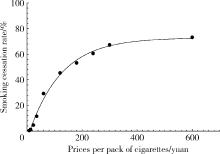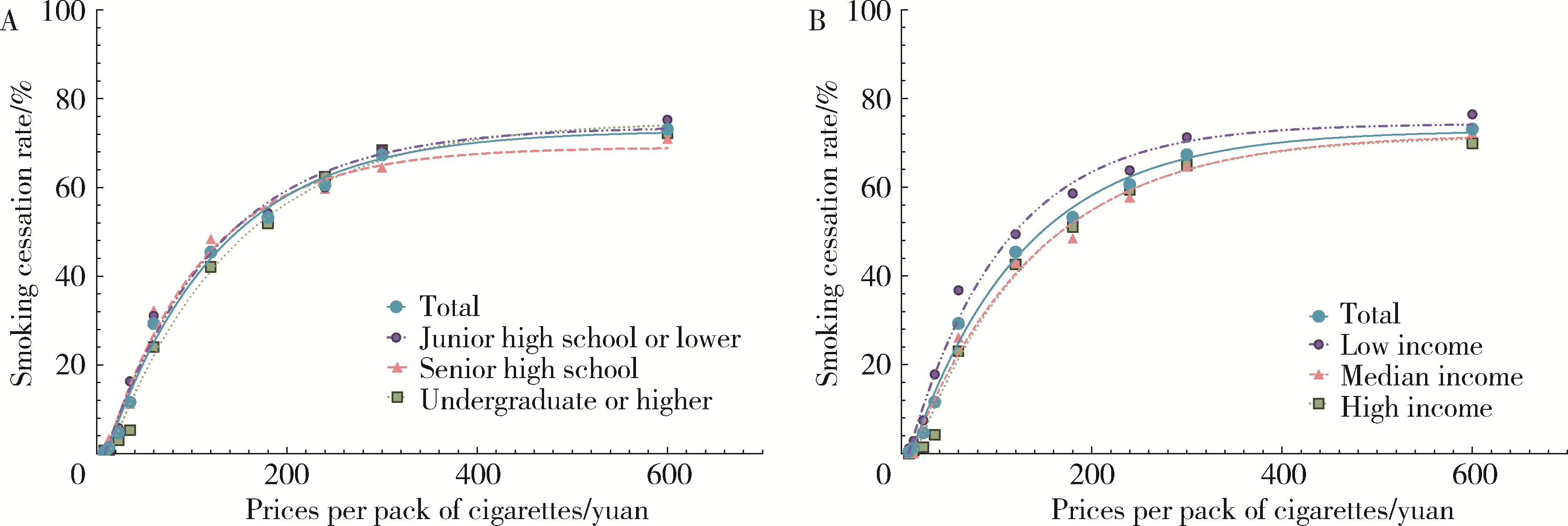Journal of Peking University (Health Sciences) ›› 2024, Vol. 56 ›› Issue (3): 479-486. doi: 10.19723/j.issn.1671-167X.2024.03.015
Previous Articles Next Articles
Application of the cigarette purchase tasks in achieving China' s tobacco control goals
Xiaochen YANG1,Wangnan CAO1,Haoxiang LIN2,Lanchao ZHANG1,Yuxin LIN1,Ziyan CHEN1,Chun CHANG1,*( )
)
- 1. Department of Social Medicine and Health Education, Peking University School of Public Health, Beijing 100191, China
2. Institute for Global Health and Development, Peking University, Beijing 100871, China
CLC Number:
- R193.3
| 1 | The Tobacco Control Office of the Chinese Center for Disease Control and Prevention. 2018 China adult tobacco survey report[EB/OL]. (2019-09-23)[2023-11-20]. https://cdn.who.int/media/docs/default-source/ncds/ncd-surveillance/data-reporting/china/2018-china-adult-tobacco-survey-report_eng.pdf. |
| 2 |
Mark G , Rong Z .Tobacco control and Healthy China 2030[J].Tobacco Control,2019,28(4):409.
doi: 10.1136/tobaccocontrol-2018-054372 |
| 3 | Atkinson AB , Townsend JL .Economic aspects of reduced smoking[J].Lancet,1977,2(8036):492-495. |
| 4 | World Health Organization. World Health Organization fact sheets. Tobacco[EB/OL]. (2023-07-31)[2023-11-20]. https://www.who.int/news-room/fact-sheets/detail/tobacco. |
| 5 | World Health Organization. WHO report on the global tobacco epidemic, 2023[EB/OL]. (2023-07-31)[2023-09-20]. https://www.who.int/publications/i/item/9789240077164. |
| 6 | 郑韵婷, 林昊翔, 云青萍, 等.控烟政策背景下北京市卷烟价格、可负担性及价格对卷烟需求的影响[J].现代预防医学,2021,48(10):1830-1833. |
| 7 | 谢莉, 姜垣.健康中国必将是无烟中国[J].中国慢性病预防与控制,2019,27(7):481-483. |
| 8 |
Yang G , Wang Y , Wu Y , et al.The road to effective tobacco control in China[J].Lancet,2015,385(9972):1019-1028.
doi: 10.1016/S0140-6736(15)60174-X |
| 9 |
Mackillop J , Murphy JG , Ray LA , et al.Further validation of a cigarette purchase task for assessing the relative reinforcing efficacy of nicotine in college smokers[J].Exp Clin Psychopharmacol,2008,16(1):57-65.
doi: 10.1037/1064-1297.16.1.57 |
| 10 |
Murphy JG , Mackillop J .Relative reinforcing efficacy of alcohol among college student drinkers[J].Exp Clin Psychopharmacol,2006,14(2):219-227.
doi: 10.1037/1064-1297.14.2.219 |
| 11 |
Reed DD , Naudé GP , Salzer AR , et al.Behavioral economic measurement of cigarette demand: A descriptive review of published approaches to the cigarette purchase task[J].Exp Clin Psychopharmacol,2020,28(6):688-705.
doi: 10.1037/pha0000347 |
| 12 |
Mead-Morse EL , Cassidy RN , Oncken C , et al.Validity of a little cigars/cigarillos purchase task in dual users of cigars and cigarettes[J].Addict Behav,2022,130,107285.
doi: 10.1016/j.addbeh.2022.107285 |
| 13 | González-Roz A , Secades-Villa R , Weidberg S , et al.Latent structure of the cigarette purchase task among treatment-seeking smokers with depression and its predictive validity on smoking abstinence[J].Nicotine Tob Res,2020,22(1):74-80. |
| 14 |
Chase HW , Mackillop J , Hogarth L .Isolating behavioural economic indices of demand in relation to nicotine dependence[J].Psychopharmacology (Berl),2013,226(2):371-380.
doi: 10.1007/s00213-012-2911-x |
| 15 |
Evemy CG , Kurti AN , Skelly JM , et al.Examining the latent factor structure of a hypothetical cigarette purchase task among pregnant women[J].Exp Clin Psychopharmacol,2023,31(1):23-28.
doi: 10.1037/pha0000571 |
| 16 |
Salhi L , Seidel L , Albert A , et al.Fagerström test for nicotine dependence as an indicator in tobacco-related studies in periodontology[J].J Periodontol,2021,92(2):298-305.
doi: 10.1002/JPER.20-0019 |
| 17 |
Glasheen C , Johnson EO , Saccone NL , et al.Is the Fagerström test for nicotine dependence invariant across secular trends in smoking? A question for cross-birth cohort analysis of nicotine dependence[J].Drug Alcohol Depend,2018,185,127-132.
doi: 10.1016/j.drugalcdep.2017.12.013 |
| 18 |
李赋, 李毅, 郭怡阳, 等.尼古丁依赖检测量表在男性吸烟精神分裂症住院患者中的试测[J].中国心理卫生杂志,2017,31(8):630-634.
doi: 10.3969/j.issn.1000-6729.2017.08.009 |
| 19 |
Jacobs EA , Bickel WK .Modeling drug consumption in the clinic using simulation procedures: Demand for heroin and cigarettes in opioid-dependent outpatients[J].Exp Clin Psychopharmacol,1999,7(4):412-426.
doi: 10.1037/1064-1297.7.4.412 |
| 20 |
Stein JS , Koffarnus MN , Snider SE , et al.Identification and management of nonsystematic purchase task data: Toward best practice[J].Exp Clin Psychopharmacol,2015,23(5):377-386.
doi: 10.1037/pha0000020 |
| 21 |
Secades-Villa R , Pericot-Valverde I , Weidberg S .Relative reinforcing efficacy of cigarettes as a predictor of smoking abstinence among treatment-seeking smokers[J].Psychopharmacology,2016,233(17):3103-3112.
doi: 10.1007/s00213-016-4350-6 |
| 22 |
Méndez D , Le TT , Warner KE .Monitoring the increase in the U.S. smoking cessation rate and its implication for future smoking prevalence[J].Nicotine Tob Res,2022,24(11):1727-1731.
doi: 10.1093/ntr/ntac115 |
| 23 |
Liu H , Rizzo JA , Sun Q , et al.How do smokers respond to cigarette taxes? Evidence from China' s cigarette industry[J].Health Econ,2015,24(10):1314-1330.
doi: 10.1002/hec.3084 |
| 24 | 郑榕, 崔凤."健康中国2030"控烟目标的实现与烟草消费税改革路径[J].国际税收,2022,(9):57-64. |
| 25 |
Chen Z , Peto R , Zhou M , et al.Contrasting male and female trends in tobacco-attributed mortality in China: evidence from successive nationwide prospective cohort studies[J].Lancet,2015,386(10002):1447-1456.
doi: 10.1016/S0140-6736(15)00340-2 |
| 26 |
Verguet S , Gauvreau CL , Mishra S , et al.The consequences of tobacco tax on household health and finances in rich and poor smokers in China: An extended cost-effectiveness analysis[J].Lancet Glob Health,2015,3(4):e206-e216.
doi: 10.1016/S2214-109X(15)70095-1 |
| 27 | Kostova D , Husain MJ , Chaloupka FJ .Effect of cigarette prices on smoking initiation and cessation in China: A duration analysis[J].Tob Control,2016,26(5):569-574. |
| 28 |
Goodchild M , Zheng R .Early assessment of China' s 2015 tobacco tax increase[J].Bull World Health Organ,2018,96(7):506-512.
doi: 10.2471/BLT.17.205989 |
| 29 | World Health Organization. WHO technical manual on tobacco tax policy and administration[EB/OL]. (2021-04-12)[2023-09-20]. https://www.who.int/publications/i/item/9789240019188. |
| [1] | Yu-xin WANG,Yu-han DENG,Yin-liang TAN,Bao-hua LIU. Predictive value of stress-induced hyperglycemia on 28 d risk of all-cause death in intensive care patients [J]. Journal of Peking University (Health Sciences), 2023, 55(3): 442-449. |
| [2] | Xiao-yue ZHANG,Yu-xin LIN,Ying JIANG,Lan-chao ZHANG,Mang-yan DONG,Hai-yi CHI,Hao-yu DONG,Li-jun MA,Zhi-jing LI,Chun CHANG. Mediating effect of self-efficacy on self-management ability and self-management behavior in patients with type 2 diabetes mellitus [J]. Journal of Peking University (Health Sciences), 2023, 55(3): 450-455. |
| [3] | Zi-wei ZHANG,Yu-meng HUA,Ai-ping LIU. Joint association of depression symptoms and 10-year risk of ischemic cardiovascular disease with the cardiovascular disease in middle-aged and elderly people in China [J]. Journal of Peking University (Health Sciences), 2023, 55(3): 465-470. |
| [4] | Ming-long CHEN,Xiao-han LIU,jing GUO. Relationship between social support and parental burnout in COVID-19 among Chinese young parents [J]. Journal of Peking University (Health Sciences), 2022, 54(3): 520-525. |
|
||



